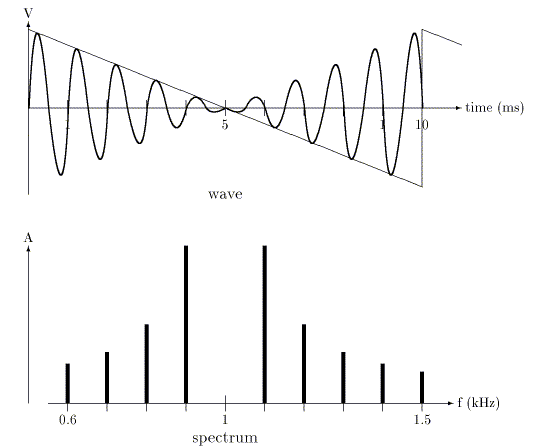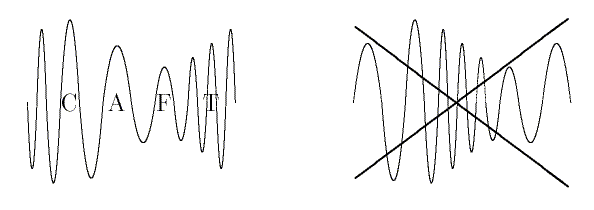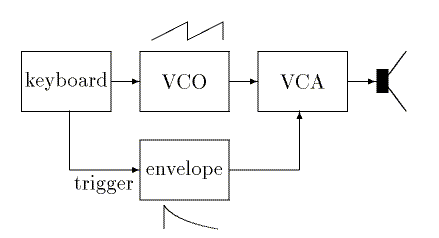Physics 102
| Physics 102 |
|
Second Hour Exam (solutions) |
| November 21, 2002 |
Please copy and sign the pledge: ``I pledge on my honor that I have not given or received any unauthorized assistance on this examination."
Instructions: This exam consists of two parts, Part I (written and drawn) to be answered on this sheet, Part II (multiple choice) to be answered on a ``scantron" answer sheet. Make sure you have both of these items, and mark your name (last name first) on the answer sheet. When you are finished, put this sheet in the alpabetical trays, and the answer sheet into a separate tray. You may detach this first sheet and keep the multiple-choice questions.
Part I (maximum 30) Part II (maximum 70) Total (of 100)
(do not write here)
Part I
1. A 1000-Hz sine wave is used as a carrier in a ring modulator, with a
100-Hz sawtooth as the modulator wave.
a. In the ``wave" graph below, draw a reasonably accurate picture of this
wave. (The sawtooth waves is already drawn for you.)
b. In the ``spectrum" graph below, draw the spectrum of this wave. (If you are not up to that, at least list some of the prominent frequencies in the modulated wave)

2. The wave from a sinusoidal source that moves back and forth with
respect to the observer appears both amplitude and frequency
modulated. Of the two graphs shown below, only one can come from
such a source. (Time is running from left to right, as usual.) To find out which, mark the following times on the graph with a letter as follows:
C: source closest to observer
A: source moving fastest away from observer
F: source farthest from observer
T: source moving fastest toward observer
You will note only one of the graphs allows consistent labeling.
Cross out the other one with a big X.

3. Describe the sound emitted by the synthesizer shown below when a key is pressed on the keyboard. (Draw the wave shape, and/or describe the sound in words).
 The sound is that of a sawtooth wave (rich in harmonics) that starts at full volume as soon as the key is pressed (short attack) and then slowly decays in amplitude (volume), keeping a constant period (pitch).
The sound is that of a sawtooth wave (rich in harmonics) that starts at full volume as soon as the key is pressed (short attack) and then slowly decays in amplitude (volume), keeping a constant period (pitch).
4. Consult the equal loudness curves on the next page and consider three tones (you may mark them on the curves)
A has f = 30 Hz and SIL = 70 db
B has f = 100 Hz and SIL = 60 db
C has f = 4000 Hz and SIL = 50 db
a. Which tone is loudest? C
b. Which tone is softest? A
c. How (by what factor) does the intensity (W/m2) of A compare to that of C? The difference is 20 dB, hence the factor is 10² = 100 (or 1/100)
d. What is the SIL of a tone of frequency 4000 Hz that sounds as loud as B? 40 dB

Equal Loudness Curves for problem 4, part I
Part II
Correct answers are in bold font
1. When Fourier synthesizing a triangle wave out of sine waves:
- it takes an infinite number of sine waves, of different harmonic frequencies
- the phases of the sine waves don't matter
- the amplitudes of the sine waves don't matter
- the synthesized triangle wave sounds different from a real triangle wave
- you don't need the odd harmonics
2. A wave whose Fourier spectrum has non-zero amplitudes at
frequencies 2f, 3f, 4f, ..., but no component at frequency f is said to have a missing fundamental. What is true about such a wave:
- It repeats with a period 1/f , and not with period 1/2f .
- The pitch we actually hear is that of the fundamental
- This pitch does not change if we add the fundamental (of frequency f) with some significant amplitude
- The tone quality changes when the fundamental is present
- All of the above.
3. In all Fourier spectra a piece of information about a wave is missing, namely
- relative phase between the harmonics
- amplitudes of the harmonics
- fundamental frequency
- frequency of the overtones
- number of harmonics present
4. An acoustical wave with a Fourier spectrum of only one or very few harmonics sounds ______; one with a large number of large-amplitude harmonics sounds _______.
- pure (simple); also pure
- pure; rich
- rich; pure
- rich; also rich
- you cannot tell the sound quality from the Fourier spectrum
5. What properties of a wave can you not tell from its Fourier spectrum:
- frequency
- period
- wave shape
- harmonic content
- whether or not it is a sine wave
6. An attack transient is
- a belligerent person in transit at an airport
- a range of frequencies that is deemphasized in a Fourier spectrum
- the sustained sound of a piano
- the beginning of a musical sound with a spectrum that differs from the steady note
- produced exclusively by tounging a wind instrument
7. Inharmonicities are present in the sound of
- a stiff string, such as that of the piano
- tuned percussion instruments, such as timpani
- chimes
- a bell
- all of the above
8. A formant refers to
- musical instruments trated with formic acid
- the unque sound produced by formica
- an acoustical experience during the formative years
- the complement of a dormant
- a frequency range of emphasized harmonics
9. A steady-state nonmusical sound that contains a continuum of frequencies of unequal intensities is called
- a continuo
- white noise
- colored noise
- pink noise
- a fuzzy tone
10. The Helmholz resonator is important because
- it possesses a single, low, isolated resonant frequency
- it was the first resonator made of wood (= holz in German)
- its resonances conform exactly to the overtone series
- its resonant frequencies can be calculated accurately
- a single resonator can verify the existence of many harmonics in complex tones
11. The effect of amplitude modulation can be heard as
- a balance between loud and soft passages of music
- a periodic variation in pitch of a tone
- a pulsing or throbbing tone, continually varying in loudness
- elimination of weaker sounds in favor of louder sounds
- a vibrato
12. What is true about balanced modulation when modulator and carrier are both sine waves?
- It is an amplitude modulation with zero offset level
- Its graph is the same as the graph of beats
- The carrier frequency is absent from the Fourier spectrum
- It can produce nonintegral overtones
- All of the above
13. A sine wave of frequency 900 Hz alternates once every second with one of 1100 Hz and the same amplitude. To produce this, using as modulator a square wave of period 1 sec (and zero offset), we should
- amplitude modulate a 900 Hz sine wave
- amplitude modulate a 1100 Hz sine wave
- frequency modulate a 900 Hz sine wave
- frequency modulate a 1100 Hz sine wave
- frequency modulate a 1000 Hz sine wave
14. A clarinet tone has strong odd-numbered harmonics and weak even-numbered ones. To synthesize a clarinet sound one therefore starts with
- a sine wave
- a square wave
- a sawtooth wave
- a pulse train
- a microwave
To answer questions 15-50, use the key
- = VCO
- = VCA
- = filter
- = LFO (low-frequency oscillator)
- = envelope generator
to match these devices to their function in a synthesizer:
15. generates the audio signal: 1
16. generates the control signal to produce tremulo or vibrato: 4
17. produces tremulo in response to input signal of previous question: 2
18. emphasizes or deemphasizes some range of harmonics: 3
19. controls attack and decay transients: 5
20. can produce colored noise from white noise: 3
21. A digital-to-analog converter
- changes numbers in base 2 to numbers in base 10
- changes numbers in base 10 to numbers in base 2
- finds analogies in digital signals
- changes discrete electronic signals to a smoothly varying voltage
- samples a wave at discrete time steps
22. Which filter would you use to change a triangle wave into a sine wave?
- bandpass
- low-pass (both answers counted as correct)
- high-pass
- notch
- forward pass
23. A Helmholz resonator with a small nipple, to be inserted in the experimenter's ear, can be considered a type of filter. What type?
- bandpass
- low-pass
- high-pass
- notch
- St. Gotthard pass
24. The number 128, expressed in binary, is 10000000. The number 129 is
- 10000001
- 20000000
- 10000009
- 10000129
- 10001001
25. The number 127, expressed in binary is
- 09999999
- 10000111
- 09990111
- 01010111
- 01111111
26. In the ear, the cells that convert sound vibration into nerve signals are located
- in the auditory canal
- on the eardrum
- in the middle ear
- in the eustachian tube
- in the cochlea
27. According to the place theory of hearing,
- we use hearing principally to locate the place where the sound originated
- the amplitude of a sound is correlated with its place on the SIL scale
- the frequency of a sine wave is correlated with a position of maximum response on a membrane inside the ear
- a unique place in the inner ear determines the perceived tone quality of a sound
28. Although a sawtooth wave of frequency 200 Hz contains also
harmonics at 400 Hz, 600 Hz, 800 Hz, etc., we perceive its pitch as
that of 200 Hz. When the wave is sent through a filter that removes
all the frequencies below 300 Hz, what happens to its perceived pitch?
- it rises by a fifth, corresponding to 300 Hz
- it rises by an octave, corresponding to 400 Hz
- it falls by an octave to 100Hz, the difference frequency
- it does not change
29. Bernoulli's principle was shown in a lecture demonstration where
- air was blown between thin metal sheets and they flew apart
- air was blown between thin metal sheets and they moved together
- phases were changed in a wave synthesis without change in sound quality
- phases were changed in a wave synthesis with some change in sound quality
- quality beats could be heard
30. The SIL of one string instrument playing "mezzo forte" is 30 db.
Two such instruments play a duet together. If everything else is the same
(loudness of each player, distance to listener etc), what it the SIL of the duet?
- 33 db
- 36 db
- 60 db
- 120 db
31. Four players like the one of problem 30 join to play a quartet.
What is its SIL?
- 33 db
- 36 db
- 60 db
- 120 db
32. The listener moves away from the quartet of problem 31 so that
the SIL at his position decreases back to 30 db (as it was for one
player in problem 30). By what factor has he increased his distance?
- 2
- 3
- 6
- 30
- 36
33. A difference between the critical band and the JND for frequency is that
- the critical band is more than a factor 10 larger than the JND
- some frequencies in the critical band can be distinguished, but frequencies in the range of one JND
cannot be distinguished
- the critical band can be determined from the sound of two simultaneous sine waves of different frequency, where as the JND is best determined by listening to the two separate waves in succession
- all of the above
34. The bottles in the "bottle band" were fine tuned by
- partially closing the neck with duct tape
- partially filling them with water
- selecting a different shape bottle for each note to be played
- adding a mouthpiece of appropriate length to each neck
- there was no fine tuning, the sound was meant to be out of tune
35. Masking refers to
- adjusting the opening of an instrument, as in the bottle band
- a voluntary act of ignoring background noise in favor of spoken words
- the change in Fourier spectrum of a sound by intervening obstacles
- the inaudibility of a "masked tone" in the presence of a louder "masking tone"
End of Exam!



 The sound is that of a sawtooth wave (rich in harmonics) that starts at full volume as soon as the key is pressed (short attack) and then slowly decays in amplitude (volume), keeping a constant period (pitch).
The sound is that of a sawtooth wave (rich in harmonics) that starts at full volume as soon as the key is pressed (short attack) and then slowly decays in amplitude (volume), keeping a constant period (pitch).